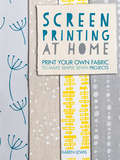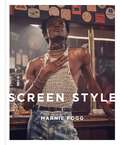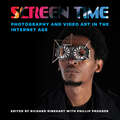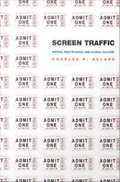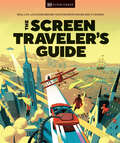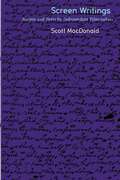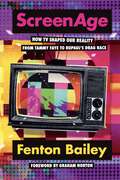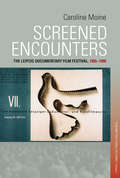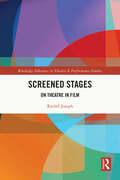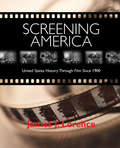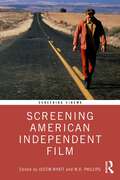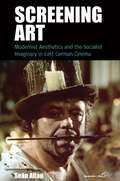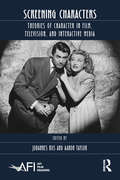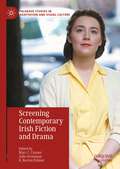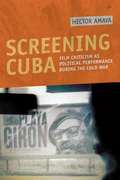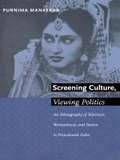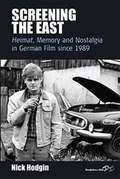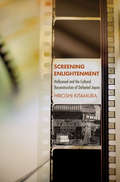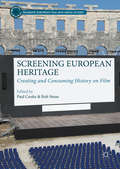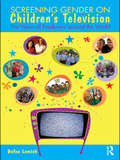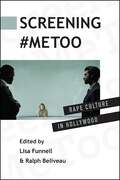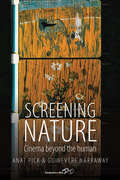- Table View
- List View
Screen Printing at Home: Print Your Own Fabric to Make Simple Sewn Projects
by Karen LewisCreate hand-printed fabrics—and use them to make aprons, tote bags, and more! Do you love the idea of printing your own fabrics at home but don&’t know where to start? This comprehensive guide to screen printing shows you just how easy it is to create beautiful, hand-printed fabrics at your kitchen table. Screen printing expert Karen Lewis demonstrates two screen printing techniques—stenciling and screen filler—and how they can be used to create stunning, professional results with basic, inexpensive equipment. Both techniques are explained using step-by-step text and photography. Karen also explains how to create simple, sewn projects from your hand-printed fabrics. The sewing patterns include an apron, tote bag, and tea cozy, as well as ideas for how to print on ready-made items like tea towels to make delightful gifts for friends and family.
Screen Style
by Marnie FoggScreen Style celebrates the beautiful, stylish and often covetable outfits and costumes featured in 50 iconic and diverse series of the small screen: from Mad Men to Call My Agent, Bridgerton to Empire.By organising the series into genres - Comedy, Coming of Age, Crime, Historical, Retro, Contemporary - the author shows how designers take different approaches when manipulating the latent power of dress to create convincing characters and enhance the experience of the viewer. She reveals how the characters themselves can become role models for what to wear, transforming actors into fashion influencers.The book is beautifully illustrated with over 250 screen stills, each accompanied by an extended caption, further demonstrating how TV series have helped to set the standard for fashion on and off screen.
Screen Style
by Marnie FoggScreen Style celebrates the beautiful, stylish and often covetable outfits and costumes featured in 50 iconic and diverse series of the small screen: from Mad Men to Call My Agent, Bridgerton to Empire.By organising the series into genres - Comedy, Coming of Age, Crime, Historical, Retro, Contemporary - the author shows how designers take different approaches when manipulating the latent power of dress to create convincing characters and enhance the experience of the viewer. She reveals how the characters themselves can become role models for what to wear, transforming actors into fashion influencers.The book is beautifully illustrated with over 250 screen stills, each accompanied by an extended caption, further demonstrating how TV series have helped to set the standard for fashion on and off screen.
Screen Time: Photography and Video Art in the Internet Age
by Richard Rinehart and Phillip ProdgerPublished on the occasion of the art exhibition Screen Time: Photography and Video Art in the Internet Age, this catalog features a selection of leading international artists who engage with and critique the role of media in contemporary society. Their work demonstrates what has become known as post-internet artistic practices—art that may or may not be made for the internet but nevertheless acknowledges online culture as an omnipresent influence, inseparable from contemporary social conditions. They ask what it means to be a photographer when everyone is an Instagram influencer; what it means to make video art when everyone is a TikTok video star; and how to deliver meaningful social commentary in the age of the meme. The exhibition and accompanying catalog showcase artwork by N. Dash, Nathalie Djurberg, Marcel Dzama, Peter Funch, Cyrus Kabiru, William Kentridge, Christian Marclay, Marilyn Minter, Vik Muniz, Otobong Nkanga, Erwin Olaf, Robin Rhode, Vee Speers, Mary Sue, Puck Verkade, Huang Yan. Published by Bucknell University Press for the Samek Art Museum. Distributed worldwide by Rutgers University Press.
Screen Traffic: Movies, Multiplexes, and Global Culture
by Charles R. AclandIn Screen Traffic, Charles R. Acland examines how, since the mid-1980s, the U. S. commercial movie business has altered conceptions of moviegoing both within the industry and among audiences. He shows how studios, in their increasing reliance on revenues from international audiences and from the ancillary markets of television, videotape, DVD, and pay-per-view, have cultivated an understanding of their commodities as mutating global products. Consequently, the cultural practice of moviegoing has changed significantly, as has the place of the cinema in relation to other sites of leisure. Integrating film and cultural theory with close analysis of promotional materials, entertainment news, trade publications, and economic reports, Acland presents an array of evidence for the new understanding of movies and moviegoing that has developed within popular culture and the entertainment industry. In particular, he dissects a key development: the rise of the megaplex, characterized by large auditoriums, plentiful screens, and consumer activities other than film viewing. He traces its genesis from the re-entry of studios into the movie exhibition business in 1986 through 1998, when reports of the economic destabilization of exhibition began to surface, just as the rise of so-called e-cinema signaled another wave of change. Documenting the current tendency toward an accelerated cinema culture, one that appears to arrive simultaneously for everyone, everywhere, Screen Traffic unearths and critiques the corporate and cultural forces contributing to the "felt internationalism" of our global era.
The Screen Traveler's Guide: Real-life Locations Behind Your Favorite Movies and TV Shows
by DKPut yourself in the movie! Step inside dozens of real-life locations with this gloriously geeky, map-filled compendium.Locations are everything. They transport us to far-flung worlds and dystopian futures, and provide the backdrop to intergalactic battles and rampaging monsters. Our most obsessed-about stories would be nothing without them.Meticulously researched and compiled by self-proclaimed superfans and travel experts, The Screen Traveler&’s Guide maps the real-life locations behind your favorite shows and scenes. Follow the Avengers&’ battle of New York, discover the Croatian location for Game of Thrones&’ King&’s Landing, find out how New Zealand transformed into Lord of the Rings&’ Middle Earth, uncover exactly where the magical world of Harry Potter is set – and much more.Along the way, you&’ll discover the landmarks to avoid during an alien invasion, the strangest location stand-ins (did you know, for example, that Liverpool stood in for Brooklyn in Captain America?), the place that&’s doubled as more countries than any other, and lots of travel inspiration from your pop culture cornerstones. Welcome to the ultimate travel guide for every screen geek.
Screen Writings: Texts and Scripts from Independent Films
by Scott MacDonald"Ask audience to cut the part of the image on the screen that they don't like. Supply scissors."—Yoko Ono, Tokyo, June 1964A dazzling range of unconventional film scripts and texts, many published for the first time, make up Scott MacDonald's newest collection. Illustrated with nearly 100 film stills, this fascinating book is at once a reference work of film history and an unparalleled sampling of experimental "language art." It contributes to the very dissipation of boundaries between cinematic, literary, and artistic expression thematized in the films themselves. Each text and script is introduced and contextualized by MacDonald; a filmography and a bibliography round out the volume.This is a readable—often quite funny—literature that investigates differences between seeing and reading. Represented are avant-garde classics such as Hollis Frampton's Poetic Justice and Zorns Lemma and Morgan Fisher's Standard Gauge, and William Greaves's recently rediscovered Symbiopsychotaxiplasm: Take One. Michael Snow turns film loose on language in So Is This; Peter Rose turns language loose on theory in Pressures of the Text.Some of the most influential feminist filmscripts of recent decades—Laura Mulvey and Peter Wollen's Riddles of the Sphinx, Su Friedrich's Gently Down the Stream, Trinh T. Minh-ha's Reassemblage, Yvonne Rainer's Privilege—confirm this book's importance for readers in gender and cultural studies as well as for filmmakers and admirers of experimental writing, independent cinema, and the visual arts in general.
ScreenAge: How TV shaped our reality, from Tammy Faye to RuPaul’s Drag Race
by Fenton Bailey'Like a superheated kernel of corn, the world has gone Pop... Drag has become mainstream. Being gay became cool. From being the criminal outsider, being queer has even become representative of the way the outsider voice is common to us all.'When he moved to New York in 1982, Fenton Bailey saw the world go Pop. Together with filmmaking partner Randy Barbato, their production company World of Wonder would pioneer the genre of Reality TV and chronicle the emerging Screen Age through their extraordinary programs and outrageous subjects - from Bible Belt televangelists and conspiracy theories to pioneering drag queens.Working with icons such as Britney Spears, Tammy Faye Bakker and RuPaul, the production company's shows tell a wider story of how television has fundamentally shifted our reality.Packed with glorious insider gossip and amazing celebrity stories, these are the riotous tales behind the shows that would make ScreenAgers of us all.
Screened Encounters: The Leipzig Documentary Film Festival, 1955-1990 (Film and the Global Cold War #1)
by Caroline MoineEstablished in 1955, the Leipzig International Documentary Film Festival became a central arena for staging the cultural politics of the German Democratic Republic, both domestically and in relation to West Germany and the rest of the world.�Screened Encounters�represents the definitive history of this key event, recounting the political and artistic exchanges it enabled from its founding until German unification, and tracing the outsize influence it exerted on international cultural relations during the Cold War.
Screened Stages: On Theatre in Film (ISSN)
by Rachel JosephThis book is devoted to tracing the variety of ways that theatre, theatricality, and performance are embedded in Hollywood cinema as screened stages.A screened stage is the literal or metaphorical appearance of a stage on screen. When the Hollywood style emerged in cinema history it traumatically severed the entwined relationship between film and theatre. The book makes the argument that cinema longs for theatre after that separation. The histories of stage and screen persistently crisscross one another making their separation problematic. The screened stage from the end of the nineteenth century until now offers a miniaturized version of cinema and theatre history. Moments of the stage within the screen compress historical styles and movements into saturated representations on film. Such examples overflow the cinematic screen into singular manifestations of presentness. Screened stages uncover what it means to be simultaneously present and absent.This book would be of great interest to students and scholars of theatre, film, dance, and performance.
Screening America: United States History through Film since 1900
by James J LorenceBy combining the study of films with the text-based primary sources, Screening America gives students clear guidance in studying, interpreting, and understanding the motion picture's significance as a primary source in investigating U.S. History.Students will come to understand history as not only the record of what governments did, but also the way in which people lived their lives, experienced the wider world, and engaged in leisure pursuits, from which we can learn much about the society in which they lived.
Screening American Independent Film (Screening Cinema)
by Justin Wyatt W. D. PhillipsThis indispensable collection offers 51 chapters, each focused on a distinct American independent film. Screening American Independent Film presents these films chronologically, addressing works from across more than a century (1915−2020), emphasizing the breadth and long duration of American independent cinema. The collection includes canonical examples as well as films that push against and expand the definitions of "independence." The titles run from micro-budget films through marketing-friendly Indiewood projects, from auteur-driven films and festival darlings to B-movies, genre pics, and exploitation films. The chapters also introduce students to different approaches within film studies including historical and contextual framing, industrial and institutional analysis, politics and ideology, genre and authorship, representation, film analysis, exhibition and reception, and technology. Written by leading international scholars and emerging talents in film studies, this volume is the first of its kind. Paying particular attention to issues of diversity and inclusion for both the participating scholars and the content and themes within the selected films, Screening American Independent Film is an essential resource for anyone teaching or studying American cinema.
Screening Art: Modernist Aesthetics and the Socialist Imaginary in East German Cinema (Film Europa #20)
by Seán AllanWith internationalist aspirations and wide-ranging historical perspectives, East German films about artists and their work became hotly contested spaces in which filmmakers could look beyond the GDR and debate the impact of contemporary cultural policy on the reception of their pre-war cultural heritage. Spanning newsreels, documentaries, and feature films, Screening Art is the first full-length investigation into a genre that has been largely overlooked in studies of DEFA, the state-owned Eastern German film studio. As it shows, “artist-films” played an essential role in the development of new paradigms of socialist art in postwar Europe.
Screening Characters: Theories of Character in Film, Television, and Interactive Media (AFI Film Readers)
by Johannes Riis Aaron TaylorCharacters are central to our experiences of screened fictions and invite a host of questions. The contributors to Screening Characters draw on archival material, interviews, philosophical inquiry, and conceptual analysis in order to give new, thought-provoking answers to these queries. Providing multifaceted accounts of the nature of screen characters, contributions are organized around a series of important subjects, including issues of class, race, ethics, and generic types as they are encountered in moving image media. These topics, in turn, are personified by such memorable figures as Cary Grant, Jon Hamm, Audrey Hepburn, and Seul-gi Kim, in addition to avatars, online personalities, animated characters, and the ensembles of shows such as The Sopranos, Mad Men, and Breaking Bad.
Screening Contemporary Irish Fiction and Drama (Palgrave Studies in Adaptation and Visual Culture)
by Marc C. Conner Julie Grossman R. Barton PalmerIn this book, each chapter explores significant Irish texts in their literary, cultural, and historical contexts. With an introduction that establishes the multiple critical contexts for Irish cinema, literature, and their adaptive textual worlds, the volume addresses some of the most popular and important late 20th-Century and 21st Century works that have had an impact on the Irish and global cinema and literary landscape. A remarkable series of acclaimed and profitable domestic productions during the past three decades has accompanied, while chronicling, Ireland’s struggle with self-identity, national consciousness, and cultural expression, such that the story of contemporary Irish cinema is in many ways the story of the young nation’s growth pains and travails. Whereas Irish literature had long stood as the nation’s foremost artistic achievement, it is not too much to say that film now rivals literature as Ireland’s key form of cultural expression. The proliferation of successful screen versionings of Irish fiction and drama shows how intimately the contemporary Irish cinema is tied to the project of both understanding and complicating (even denying) a national identity that has undergone radical change during the past three decades. This present volume is the first to present a collective accounting of that productive synergy, which has seen so much of contemporary Irish literature transferred to the screen.
Screening Cuba: Film Criticism as Political Performance during the Cold War
by Hector AmayaHector Amaya advances into new territory in Latin American and U.S. cinema studies in this innovative analysis of the differing critical receptions of Cuban film in Cuba and the United States during the Cold War. Synthesizing film reviews, magazine articles, and other primary documents, Screening Cuba compares Cuban and U.S. reactions to four Cuban films: Memories of Underdevelopment, Lucia, One Way or Another, and Portrait of Teresa. In examining cultural production through the lens of the Cold War, Amaya reveals how contrasting interpretations of Cuban and U.S. critics are the result of the political cultures in which they operated. While Cuban critics viewed the films as powerful symbols of the social promises of the Cuban revolution, liberal and leftist American critics found meaning in the films as representations of anti-establishment progressive values and Cold War discourses. By contrasting the hermeneutics of Cuban and U.S. culture, criticism, and citizenship, Amaya argues that critical receptions of political films constitute a kind of civic public behavior.
Screening Culture, Viewing Politics: An Ethnography of Television, Womanhood, and Nation in Postcolonial India
by Purnima MankekarIn Screening Culture, Viewing Politics Purnima Mankekar presents a cutting-edge ethnography of television-viewing in India. With a focus on the responses of upwardly-mobile, yet lower-to-middle class urban women to state-sponsored entertainment serials, Mankekar demonstrates how television in India has profoundly shaped women's place in the family, community, and nation, and the crucial role it has played in the realignment of class, caste, consumption, religion, and politics. Mankekar examines both "entertainment" narratives and advertisements designed to convey particular ideas about the nation. Organizing her study around the recurring themes in these shows--Indian womanhood, family, community, constructions of historical memory, development, integration, and sometimes violence--Mankekar dissects both the messages televised and her New Delhi subjects' perceptions of and reactions to these messages. In the process, her ethnographic analysis reveals the texture of these women's daily lives, social relationships, and everyday practices. Throughout her study, Mankekar remains attentive to the tumultuous historical and political context in the midst of which these programs' integrationalist messages are transmitted, to the cultural diversity of the viewership, and to her own role as ethnographer. In an enlightening epilogue she describes the effect of satellite television and transnational programming to India in the 1990s. Through its ethnographic and theoretical richness, Screening Culture, Viewing Politics forces a reexamination of the relationship between mass media, social life, and identity and nation formation in non-Western contexts. As such, it represents a major contribution to a number of fields, including media and communication studies, feminist studies, anthropology, South Asian studies, and cultural studies.
Screening Early Modern Drama
by Pascale AebischerWhile film adaptations of Shakespeare's plays captured the popular imagination at the turn of the last century, independent filmmakers began to adapt the plays of Shakespeare's contemporaries. The roots of their films in European avant-garde cinema and the plays' politically subversive, sexually transgressive and violent subject matter challenge Shakespeare's cultural dominance and the conventions of mainstream cinema. In Screening Early Modern Drama, Pascale Aebischer shows how director Derek Jarman constructed an alternative, dissident, approach to filming literary heritage in his 'queer' Caravaggio and Edward II, providing models for subsequent filmmakers such as Mike Figgis, Peter Greenaway, Alex Cox and Sarah Harding. Aebischer explains how the advent of digital video has led to an explosion in low-budget screen versions of early modern drama. The only comprehensive analysis of early modern drama on screen to date, this groundbreaking study also includes an extensive annotated filmography listing forty-eight surviving adaptations.
Screening The East
by Nick HodginScreening the East considers German filmmakers' responses to unification. In particular, it traces the representation of the East German community in films made since 1989 and considers whether these narratives challenge or reinforce the notion of a separate East German identity. The book identifies and analyses a large number of films, from internationally successful box-office hits, to lesser-known productions, many of which are discussed here for the first time. Providing an insight into the films' historical and political context, it considers related issues such as stereotyping, racism, regional particularism and the Germans' confrontation with the past.
Screening Enlightenment: Hollywood and the Cultural Reconstruction of Defeated Japan (The United States in the World)
by Hiroshi KitamuraDuring the six-and-a-half-year occupation of Japan (1945–1952), U.S. film studios—in close coordination with Douglas MacArthur's Supreme Command for the Allied Powers—launched an ambitious campaign to extend their power and influence in a historically rich but challenging film market. In this far-reaching "enlightenment campaign," Hollywood studios disseminated more than six hundred films to theaters, earned significant profits, and showcased the American way of life as a political, social, and cultural model for the war-shattered Japanese population. In Screening Enlightenment, Hiroshi Kitamura shows how this expansive attempt at cultural globalization helped transform Japan into one of Hollywood's key markets. He also demonstrates the prominent role American cinema played in the "reeducation" and "reorientation" of the Japanese on behalf of the U.S. government.According to Kitamura, Hollywood achieved widespread results by turning to the support of U.S. government and military authorities, which offered privileged deals to American movies while rigorously controlling Japanese and other cinematic products. The presentation of American ideas and values as an emblem of culture, democracy, and sophistication also allowed the U.S. film industry to expand. However, the studios' efforts would not have been nearly as extensive without the Japanese intermediaries and consumers who interestingly served as the program's best publicists. Drawing on a wide range of sources, from studio memos and official documents of the occupation to publicity materials and Japanese fan magazines, Kitamura shows how many Japanese supported Hollywood and became active agents of Americanization. A truly interdisciplinary book that combines U.S. diplomatic and cultural history, film and media studies, and modern Japanese history, Screening Enlightenment offers new insights into the origins of this unique political and cultural transpacific relationship.
Screening European Heritage
by Rob Stone Paul CookeThis book provides a unique examination of the way Europe's past is represented on contemporary screens and what this says about contemporary cultural attitudes to history. How do historical dramas come to TV and cinema screens across Europe? How is this shaped by the policies and practices of cultural institutions, from media funding boards to tourist agencies and heritage sites? Who watches these productions and how are they consumed in cinemas, on TV and online?, are just some of the questions this volume seeks to answer. From The Lives of Others to Game of Thrones, historical dramas are a particularly visible part of mainstream European film production, often generating major national debates on the role of the past in contemporary national identity construction.
Screening Gender on Children's Television: The Views of Producers around the World
by Dafna LemishScreening Gender on Children’s Television offers readers insights into the transformations taking place in the presentation of gender portrayals in television productions aimed at younger audiences. It goes far beyond a critical analysis of the existing portrayals of gender and culture by sharing media professionals’ action-oriented recommendations for change that would promote gender equity, social diversity and the wellbeing of children. Incorporating the author’s interviews with 135 producers of children’s television from 65 countries, this book discusses the role television plays in the lives of young people and, more specifically, in developing gender identity. It examines how gender images presented to children on television are intertwined with important existential and cultural concerns that occupy the social agenda worldwide, including the promotion of education for girls, prevention of HIV/AIDS and domestic violence and caring for ‘neglected’ boys who lack healthy masculine role models, as well as confronting the pressures of the beauty myth. Screening Gender on Children’s Television also explores how children’s television producers struggle to portray issues such as sex/sexuality and the preservation of local cultures in a profit-driven market which continually strives to reinforce gender segregation. The author documents pro-active attempts by producers to advance social change, illustrating how television can serve to provide positive, empowering images for children around the world. Screening Gender on Children’s Television is an accessible text which will appeal to a wide audience of media practitioners as well as students and scholars. It will be useful on a range of courses, including popular culture, gender, television and media studies. Researchers will also be interested in the breadth of this cross-cultural study and its interviewing methodology.
Screening History
by Gore VidalVidal intertwines fond recollections of films savored in the movie palaces of his Washington, D.C., boyhood with strands of autobiography and trenchant observations about American politics. Never before has the renowned author revealed so much about his own life or written with such immediacy about the forces shaping America.
Screening #MeToo: Rape Culture in Hollywood
by Lisa Funnell Ralph BeliveauScreening #MeToo offers an important and timely discussion of the pervasive nature of rape culture in Hollywood. Essays in the collection examine films released from the 1960s onward, a broad period that coincides with the end of the Motion Picture Production Code in Hollywood, which resulted in more frequent and increasingly graphic images of sex and violence being included in mainstream movies. Focusing on narratives in which surveillance and sexual violence feature prominently, contributors from North America and Europe examine a variety of film genres, including spy films, teen comedies, kitchen sink dramas, coming-of-age stories, rape/revenge films, and horror films. Reflecting the increasing social and academic awareness of sexual violence in Hollywood film and its transmission and cultivation of rape culture in the United States and abroad, they are concerned not only with the content of the films under scrutiny but also with the clear relationship between the stories, how they are being told, and the culture that produced them. Screening #MeToo challenges readers to look at mainstream Hollywood films differently, in light of attitudes about art and power, sexuality and consent, and the pleasures and frustrations of criticizing "entertainment" films from these perspectives.
Screening Nature: Cinema beyond the Human
by Anat Pick and Guinevere NarrawayEnvironmentalism and ecology are areas of rapid growth in academia and society at large. Screening Nature is the first comprehensive work that groups together the wide range of concerns in the field of cinema and the environment, and what could be termed “posthuman cinema.” It comprises key readings that highlight the centrality of nature and nonhuman animals to the cinematic medium, and to the language and institution of film. The book offers a fresh and timely intervention into contemporary film theory through a focus on the nonhuman environment as principal register in many filmic texts. Screening Nature offers an extensive resource for teachers, undergraduate students, and more advanced scholars on the intersections between the natural world and the worlds of film. It emphasizes the cross-cultural and geographically diverse relevance of the topic of cinema ecology.
